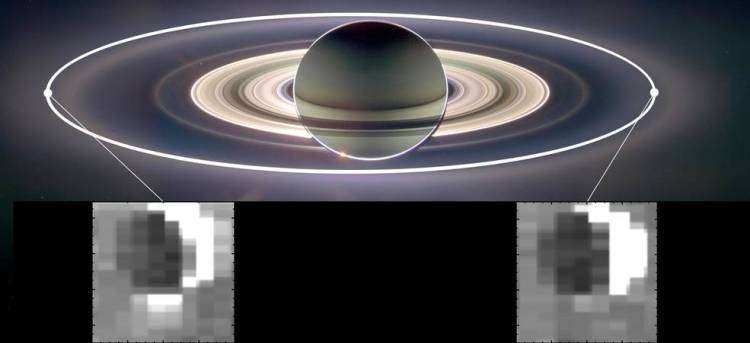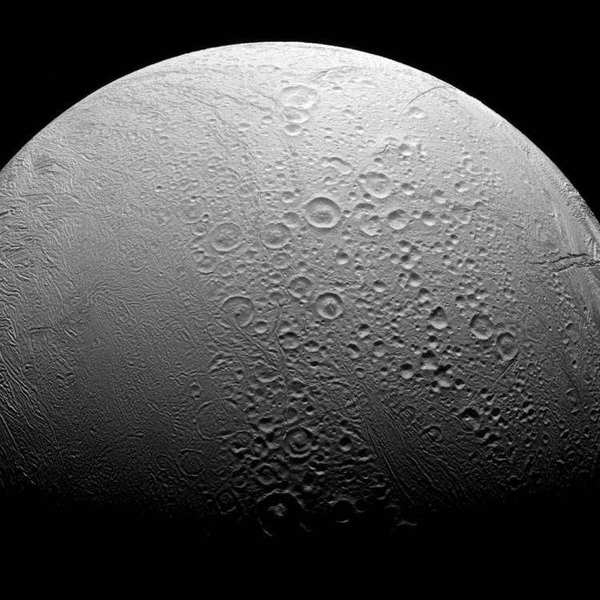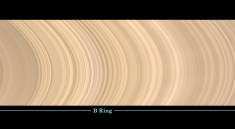
Credit: NASA/JPL-Caltech/Space Science Institute
Last Updated: Feb. 6, 2017 Editor: Tony Greicius
NASA Image of the Day: Saturn’s potentially hospitable icy moon
Seen from outside, Enceladus appears to be like most of its sibling moons: cold, icy and inhospitable. But under that forbidding exterior may exist the very conditions needed for life.
Over the course of the Cassini mission, observations have shown that Enceladus (313 miles or 504 kilometers across) not only has watery jets sending icy grains into space; under its icy crust it also has a global ocean, and may have hydrothermal activity as well. Since scientists believe liquid water is a key ingredient for life, the implications for future missions searching for life elsewhere in our solar system could be significant.
This view looks toward the Saturn-facing hemisphere of Enceladus. North on Enceladus is up and rotated 6 degrees to the right. The image was taken in green light with the Cassini spacecraft narrow-angle camera on Nov. 27, 2016.
The view was obtained at a distance of approximately 81,000 miles (130,000 kilometers) from Enceladus. Image scale is 2,566 feet (782 meters) per pixel.
The Cassini mission is a cooperative project of NASA, ESA (the European Space Agency) and the Italian Space Agency. The Jet Propulsion Laboratory, a division of the California Institute of Technology in Pasadena, manages the mission for NASA’s Science Mission Directorate, Washington. The Cassini orbiter and its two onboard cameras were designed, developed and assembled at JPL. The imaging operations center is based at the Space Science Institute in Boulder, Colorado.
For more information about the Cassini-Huygens mission visit http://saturn.jpl.nasa.gov and http://www.nasa.gov/cassini. The Cassini imaging team homepage is at http://ciclops.org.

Credits: NASA/JPL-Caltech/University of Arizona/Cornell/SSI
During a recent stargazing session, NASA’s Cassini spacecraft watched a bright star pass behind the plume of gas and dust that spews from Saturn’s icy moon Enceladus. At first, the data from that observation had scientists scratching their heads. What they saw didn’t fit their predictions.
The observation has led to a surprising new clue about the remarkable geologic activity on Enceladus: It appears that at least some of the narrow jets that erupt from the moon’s surface blast with increased fury when the moon is farther from Saturn in its orbit.
Exactly how or why that’s happening is far from clear, but the observation gives theorists new possibilities to ponder about the twists and turns in the “plumbing” under the moon’s frozen surface. Scientists are eager for such clues because, beneath its frozen shell of ice, Enceladus is an ocean world that might have the ingredients for life.

To the north, we see copious amounts of craters and evidence of the many impacts the moon has suffered in its history. However, to the south we see a smoother body with wrinkles due to geologic activity.
Most solar system bodies lacking an atmosphere are heavily cratered like Enceladus’ (313 miles or 504 kilometers across) northern region. However, the geologic activity in the south, including the famous plume above the moon’s south pole, can erase craters and leave a younger, smoother-looking surface.
This view looks toward the anti-Saturn hemisphere of Enceladus. North on Enceladus is up and rotated 4 degrees to the right. The image was taken in visible light with the Cassini spacecraft narrow-angle camera on Nov. 27, 2016. The view was obtained at a distance of approximately 41,000 miles (66,000 kilometers) from Enceladus. Image scale is 1,310 feet (398 meters) per pixel.





